Amazon Prime Day is a highly anticipated annual shopping event, offering exclusive deals and discounts to Amazon Prime members. Since its inception in 2015, to celebrate Amazon’s 20th anniversary, Prime Day has grown to rival other major shopping events like Black Friday and Cyber Monday. According to Statista, while net sales remain highest in the fourth quarter, Prime Day has markedly boosted third-quarter net sales, surpassing those of the second quarter.
At Datos, A Semrush Company, we embarked on an in-depth analysis of the 2022 & 2023 Amazon Prime Days to explore its impact on Amazon’s metrics and user behavior. Given that the US is Amazon’s largest market — accounting for 68% of annual net sales in 2023, according to Statista — we have decided to focus our analysis on US users for Amazon.com.
Our objective was to uncover trends, behaviors, and insights that define this shopping phenomenon, and to use these findings to predict future patterns for Prime Day in 2024. This study aims to shed light on how Prime Day shapes consumer activity and influences Amazon’s overall performance.
Driving User Behavior: Insights from 2023 & 2022
Traffic and User Activity
Prime Days 2022 & 2023 saw significant increases in Amazon traffic, reflecting growing anticipation due to early deals.
Specifically, there was a 50% rise in the number of users in 2023 compared to the days leading up to the event. This spike in traffic, however, proved to be temporary as numbers returned to usual levels post-Prime Day. This indicates that while Prime Days attract many visitors, they primarily come for the discounts and do not convert into regular daily users.
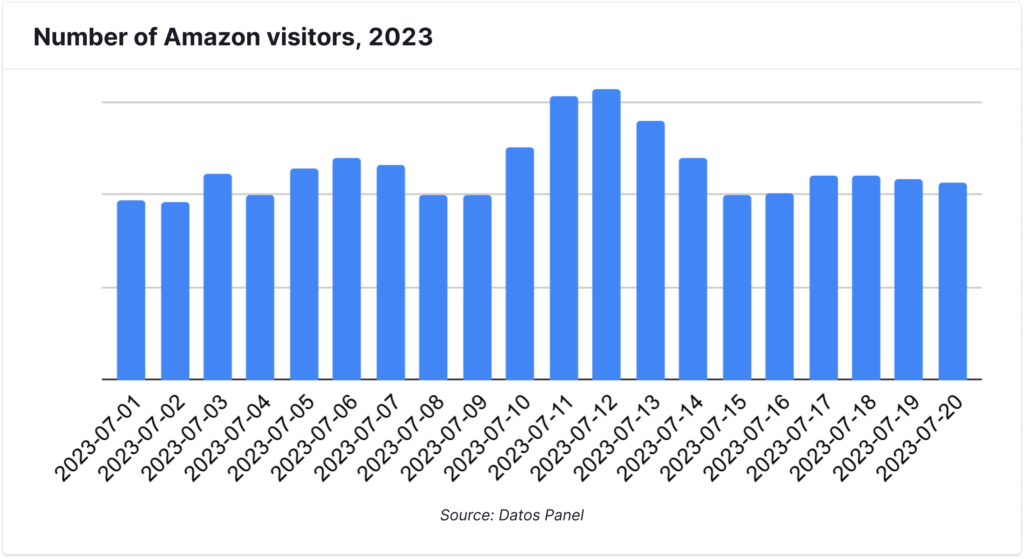
Despite the temporary nature of the user surge, Prime Day effectively converts visitors into paying customers. The number of purchases doubled, demonstrating that Prime Day shoppers are highly motivated buyers.

User activity, measured by purchases per user per day (among all who made at least one purchase), also saw a boost, jumping from an average of 1.46 purchases per user before Prime Day to 1.75 during the event, before dropping back to 1.48 post-Prime Day.
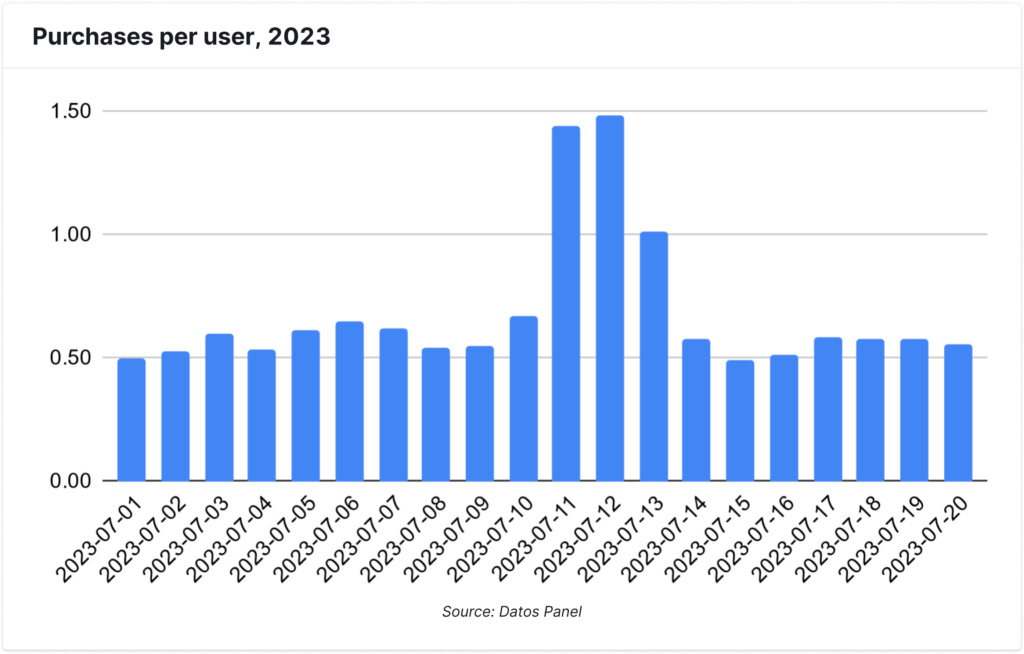
Popular Deals
According to Statista, nearly six in ten online shoppers intended to purchase consumer electronics during Prime Day 2023. An analysis of clicks on the Amazon Prime promotional page confirms this statement. The most popular deal categories during 2022 and 2023 included:
- Computers & Accessories
- Amazon Basics
- Fashion
- Electronics
- Home Products
- Movies & TV
- Video Games
Electronics, in particular, stood out as a favorite, aligning with broader trends observed in product visits and searches.
Keyword Analysis: Shifting Interests
Search Trends
User search behavior corroborates the preference for electronics. In both 2022 and 2023, “TV” was the most searched term during Prime Days. Other frequently searched keywords included Apple products, Kindle, PCs, and laptops. This indicates a focused interest in finding the best deals on high-demand electronics.

Interestingly, most of these keywords were not in the top 10 before and after Prime Day, suggesting that consumers delayed purchasing high-ticket items in anticipation of Prime Day discounts. This trend is especially true for Apple and Dyson devices, which showed the biggest change in interest during Prime Days.
Popular products
Our analysis reveals a recurring dominance of electronics during Amazon Prime Day, with Apple products, such as AirPods, consistently ranking high in terms of both visits and searches. This trend can be attributed to Apple’s robust brand loyalty and the relatively infrequent discounts on their products throughout the year. Unlike other brands that frequently offer sales, Apple maintains a strategy of limited promotions, making Prime Day a unique opportunity for consumers to purchase Apple goods at reduced prices.

Notably, the PIONEER 50-inch Class LED 4K UHD Smart Fire TV exhibited the most significant change in traffic when comparing pre- and post-Prime Day periods, emerging as the standout product in terms of increased consumer interest during the event.
Predictions for Prime Day 2024
Traffic changes
We observed that Amazon traffic during the week leading up to Prime Day in July 2024, which is held on July 16-17, slightly decreased compared to July 2023, showing a 9% decline. Additionally, interest in the Prime Day promotional page is also lower.
Here are several potential theories to explain this trend:
- Increased Competition: Competing retailers like Walmart and Target have ramped up their own promotional events to coincide with Prime Day, potentially diverting consumer attention and spending. Walmart held its largest savings event ever – Walmart Deals – on 8-11 of July, and Target had its “biggest sale of the season” – Target Circle Week – from July 7 to July 13.
- Less Aggressive Marketing: If Amazon’s marketing and promotional efforts for Prime Day 2024 were less aggressive or innovative compared to previous years, this could result in lower consumer engagement.
- Perceived Value: If consumers perceived the deals and discounts as less attractive or valuable compared to previous years, this could deter engagement.
We can see that compared to 2023, there is no change in purchases per user and the percentage of users who made purchases. Comparing the first week of July in 2023 and 2024, we observe that around 17.4% of Daily Amazon users made a purchase. During Prime Days 2023, this number increased to 26%, so we can expect a similar trend this year.
Stable Consumer Preferences
Analyzing the top search keywords in July 2023 and 2024, we see that they are very similar. Electronics and daily goods remain at the top, alongside new seasons of TV series like “The Boys” and “The Summer I Turned Pretty,” and home furniture. One notable detail is that in 2023, there was a search keyword related to Prime Day, whereas in 2024, this is not yet observed.
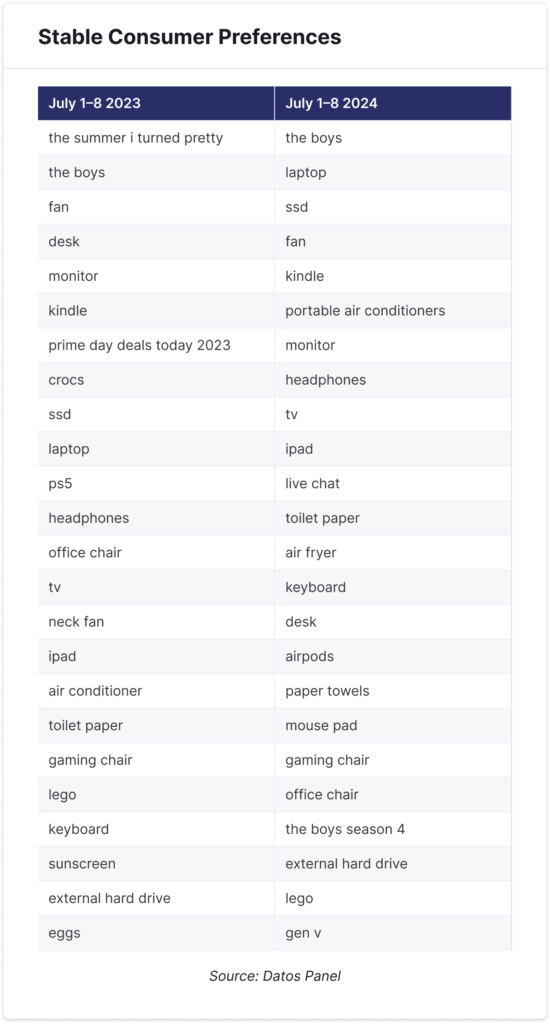
This similarity in top keywords indicates that we can anticipate continued interest in Prime Day for the same types of products.
Summary
Based on the trends observed, it is likely that future Prime Days will continue to see significant spikes in user traffic and engagement. However, maintaining this heightened activity post-event remains a challenge that Amazon can address through strategic initiatives aimed at user retention and engagement.
Key findings:
- Temporary Traffic Spike: We observed a 50% increase in users during Prime Day, though numbers return to normal post-event.
- High Conversion Rate: it’s common to see purchases per user doubling during this period, indicating highly motivated shoppers.
- Dominance of Electronics: Consistently among the top-ranked deal categories and search terms.
- Shifting Keyword Interests: Reflecting consumer behavior of delaying purchases in aim of finding better deals.
- Predictions for 2024: The consistency in top search keywords between 2023 and 2024 suggests that consumer interest in Prime Day will likely remain focused on the same types of products
Amazon Prime Day 2024
Traffic and User Activity
We’ve seen Amazon Prime Day create traffic spikes in 2022 and 2023, and then almost immediately return to previous numbers. So far, 2024 does not look like an exception. This year Amazon Prime Day drove a 34% increase, which is quite modest compared to last year’s 50%.
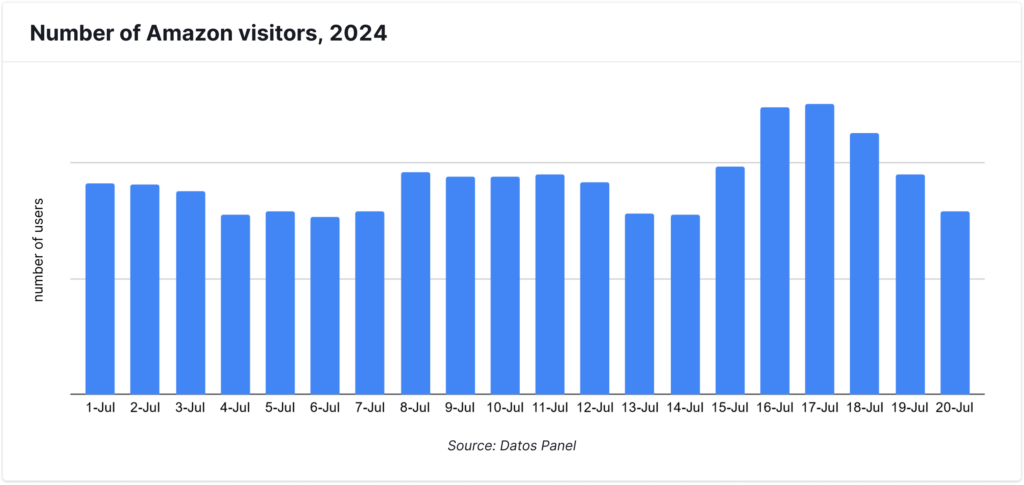
In analyzing the traffic to Prime Day-related pages, we discovered a cohort of early birds who eagerly awaited the commencement of Prime Day and visited Amazon at midnight, much to our surprise.
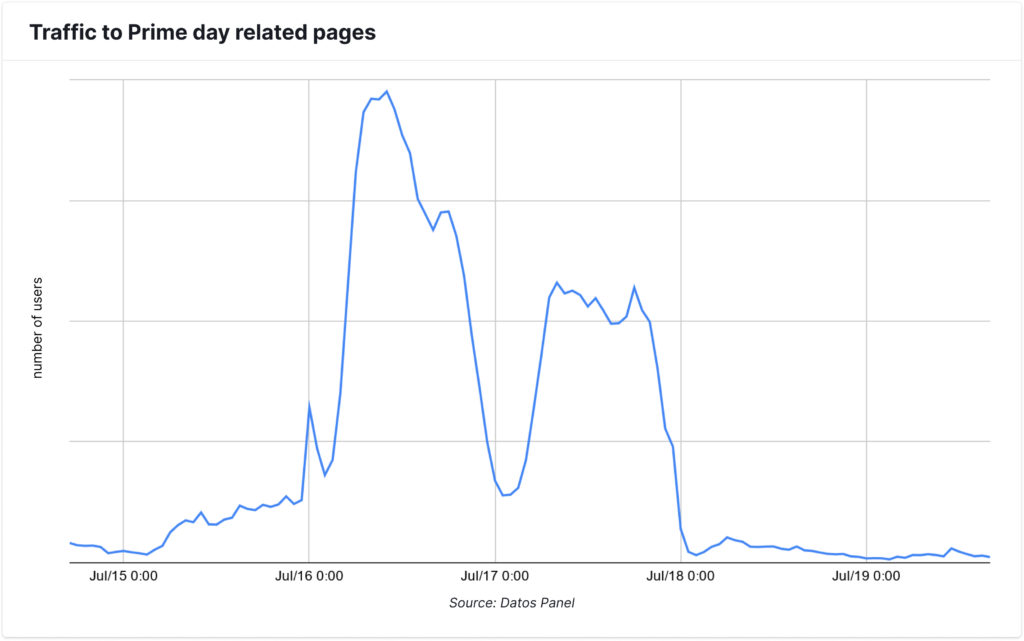
The Conversion Rate to Purchase on Prime Day continues to be remarkable. It doubled compared to the previous days, showing the user’s interest in this promo campaign.
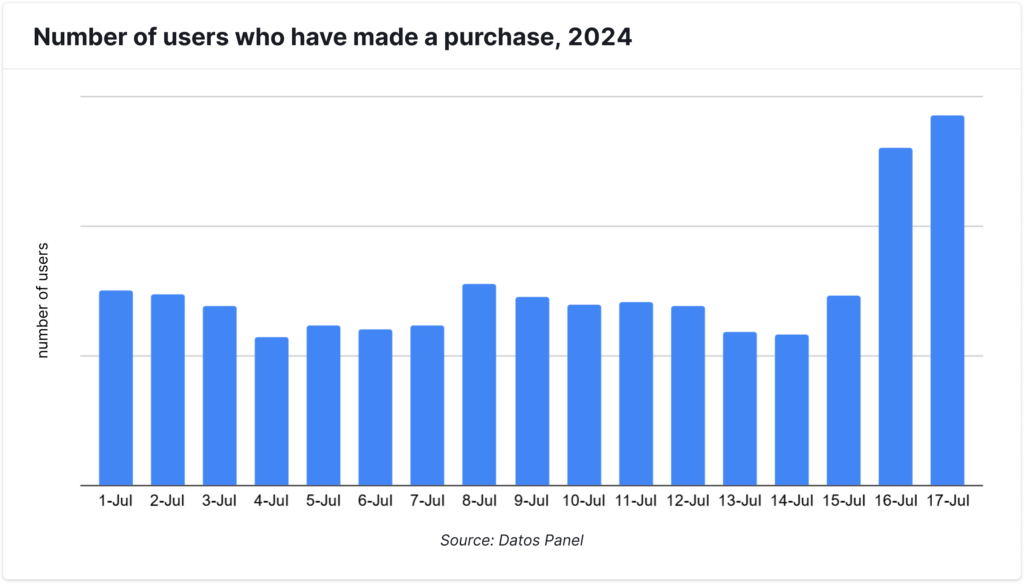
Keyword Analysis
It appears that Amazon users’ demand for electronics remains unwavering, as nine out of the top ten keywords are related to electronics. But surprisingly, the most frequently searched term is Lego.It’s worth noting that all of the keywords are regulars in Amazon’s top keywords, indicating that users tend to search for the same products they were searching for before Prime Day.

As for the keywords outside the top 10, the biggest increase in interest was seen for the following keywords: yeti, anker, golf, earbuds, espresso machine, ring, dewalt, luggage, microwave, camera.
Top Product Analysis
As was observed last year, the top products on Prime Day continue to be electronics. Apple dominates the top with two versions of AirPods being the most covered items. While Apple products were popular prior to Prime Day, Samsung, HP and Toshiba devices weren’t ranked highly before and their presence at the top is attributable solely to their promotional efforts. The most noticeable change since last year is the absence of any Amazon products at the top, which suggests a potential shift in Amazon’s layout and advertising strategy.

Outage Concerns
We carefully reviewed 3 metrics that could be affected by the global CrowdStrike outage: total traffic, purchasing users, and users visiting Prime Day related pages. Despite our concerns, we found that none of these metrics were impacted. For example, total Amazon traffic by hour looks like this. You can see the repetitive dynamics depending on the hour without any drastic ups and downs on July 17.
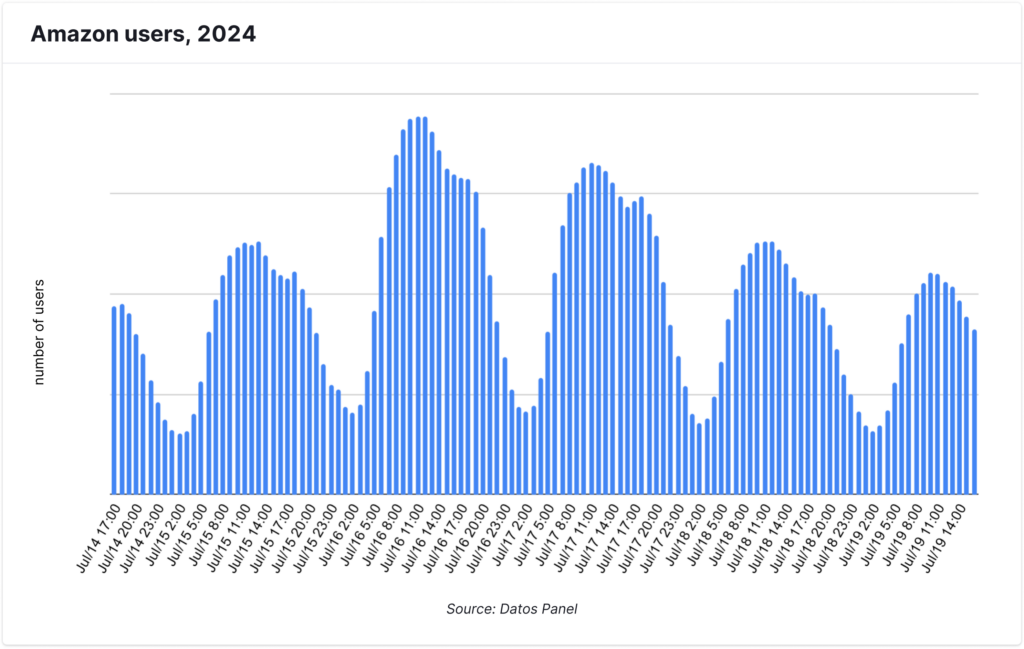

Notes on data presentation/methodology
The data displayed in this report has been provided by Datos, A Semrush Company. The analysis is based on Datos’s US panel, representing a diverse and statistically significant sample of users, and covers the months of July 2022 to July 2024. For further information please review our Privacy Policy.



